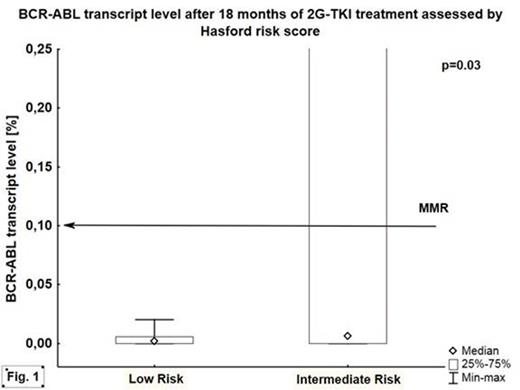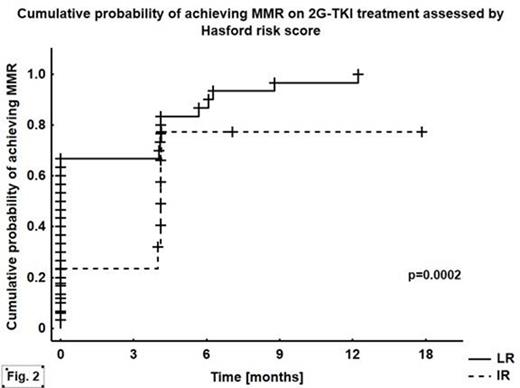Abstract
BACKGROUND: Chronic myeloid leukemia (CML) has been a model disease for a variety of studies concerning scoring systems, graft versus leukemia effect or tyrosine kinase inhibitors (TKI) treatment for many years. Scoring systems playing an important role in modern medicine to establish risk-adjusted optimal therapy [1] have been always essential for CML changing treatment modalities [1-3]. The three principal risk scores : Sokal [2], Hasford [1] and European Treatment and Outcome Study (EUTOS) [3] were established in different eras of CML therapy with implications for prognosis and disease outcome [4]. Hasford metric was designed based on data of patients treated with interpheron alpha [1] and it failed to differentiate patients who achieved low and intermediate risk scores according to CCyR, MMR, and 5 years EFS [5]. However in our previous study we found Hasford score to be correlated with the long-term molecular response in patients treated with imatinib [6]. This study presents the analysis of patients treated with second generation tyrosine kinase inhibitors (2G-TKI) due to their loss of MMR on imatinib. Hasford score still distinguish patients with low and intermediate risk and correlates with 18 month molecular response. PATIENTS AND RESULTS: The original group of 88 CML patients (F/M:42/46, median age 51 (21-83), 57 low risk and 31 intermediate risk assessed by Hasford risk score) in first chronic phase without any additional chromosomal abnormalities receiving standard dose imatinib was described in our previous study [6]. Of these, 42 patients lost MMR in a median time of 47 months. Within this group we identified 20 low risk (LR) and 22 intermediate risk (IR) patients. All 42 patients were switched to 2G-TKI. The observation after 3 months of 2G-TKI treatment was also previously described. After 18 months of 2G-TKI treatment median bcr-abl transcript levels in the LR group were 0.002 (0.000-0.02) but in the IR group bcr-abl levels were 0.03 (0.000-21.1) (p=0.03, Figure 1). All 20 low risk patients achieved major molecular response (MMR). In the intermediate risk group the response rate (MMR) was approximately 73% (16/22) and there is a significant difference in a probability of achieving MMR in both groups (Fig.2, p=0.0002). CONCLUSIONS: We are aware of Hasford score limited usefulness in predicting MMR in large studies. However in our study it is still a tool to distinguish low and intermediate risk patients by their molecular response on 2G-TKI after imatinib failure. We find our results relevant to the discussion on optimizing scoring systems and first line treatment of CML patients.
REFERENCES:
1. Hasford J, Pfirrmann M, Hehlmann R, Allan NC, Baccarani M, Kluin-Nelemans JC, et al. A new prognostic score for survival of patients with chronic myeloid leukemia treated with interferon alfa. Writing Committee for the Collaborative CML Prognostic Factors Project Group. Journal of the National Cancer Institute. 1998;90:850-8.
2. Sokal JE, Cox EB, Baccarani M, Tura S, Gomez GA, Robertson JE, et al. Prognostic discrimination in "good-risk" chronic granulocytic leukemia. Blood. 1984;63:789-99.
3. Hasford J, Baccarani M, Hoffmann V, Guilhot J, Saussele S, Rosti G, et al. Predicting complete cytogenetic response and subsequent progression-free survival in 2060 patients with CML on imatinib treatment: the EUTOS score. Blood. 2011;118:686-92.
4. Hu B, Savani BN. Impact of risk score calculations in choosing front-line tyrosine kinase inhibitors for patients with newly diagnosed chronic myeloid leukemia in the chronic phase. European journal of haematology. 2014;93:179-86.
5. Yahng SA, Jang EJ, Choi SY, Oh YJ, Bang JH, Park JE, Jeon HL, Lee SE, Kim SH, Byun JY, Kim DW. Comparison of Sokal, Hasford and EUTOS Scores in Terms of Long-Term Treatment Outcome According to the Risks in Each Prognostic Model: A Single Center Data Analyzed in 255 Early Chronic Phase Chronic Myeloid Leukemia Patients Treated with Frontline Imatinib Mesylate. Blood 2012;120:Abstract 2794
6. Dybko J, Medras E, Haus O, Jazwiec B, Wrobel T, Kuliczkowski K. The Hasford Score Correlates with the Long-Term Molecular Response to Imatinib Treatment for Chronic Myeloid Leukemia Patients and May be Useful for Differentiating Low and Intermediate Risk Patients: A Single Institution Experience. Blood 2014;124:Abstract 3152
No relevant conflicts of interest to declare.
Author notes
Asterisk with author names denotes non-ASH members.



This feature is available to Subscribers Only
Sign In or Create an Account Close Modal